There were no major projects this week that were interesting enough to get six pictures of. The best that I could do was get six random pictures of random features of the landscapes. I do not actually do much to cultivate flowers, but they happen to be components of the landscapes. Most are perennials that bloom on their own. Of course, I do not mind taking credit for them.
Some blooms started late while the weather was mild, but were then accelerated as the weather suddenly warmed. It seemed that several different types of flowers needed to be deadheaded at the same time. Zonal geraniums and lily-of-the-Nile are two of the most reliable perennials that bloom on schedule no matter what. Zonal geraniums bloom sporadically most of the time, and only bloom more while the weather is warm. Lily-of-the-Nile may start a bit early or a bit late, but is always in full bloom on the fourth of July. The blooms even look like exploding fireworks. More than two weeks later, their flowers are still in full color but will slowly start to fade. Phlox was a surprise for us.
1. Can you guess what this bloom is?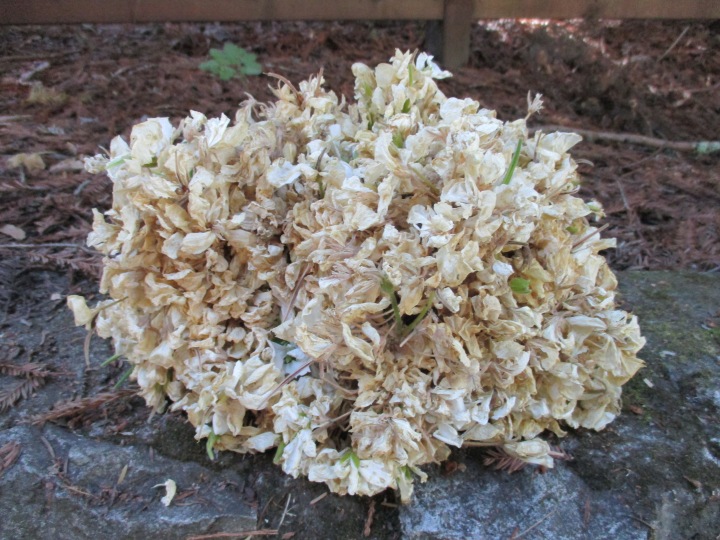
2. You can probably guess that this is phlox. It sure had my colleagues and I perplexed. We had never seen anything like it. Phlox is uncommon here. I would even say it is rare. No one knows why. It just is. I got a picture of it a few years ago only because I was intrigued by it in a neighboring landscape. It took a bit of effort to identify it, although I sort of suspected that it was phlox. It did not look quite like this phlox, and was lower to the ground. No one knows how this one got into the landscape. We suspect it arrived with the ‘fertilizer’ that the horses make for us.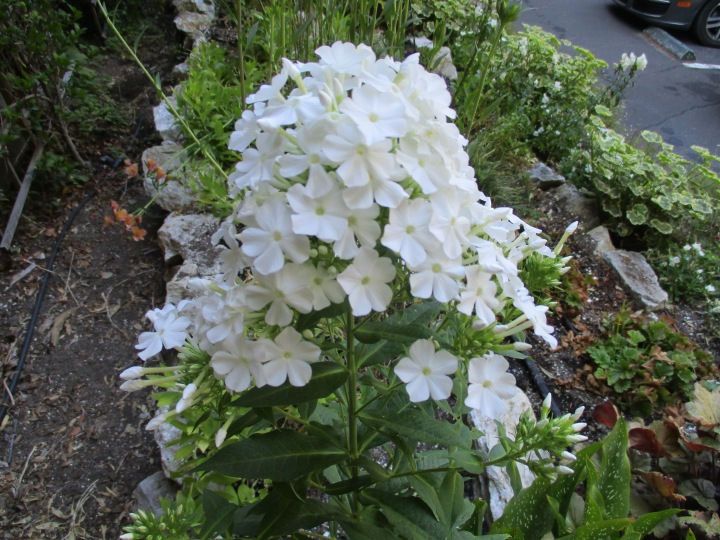
3. Lily-of-the-Nile is still one of my all time favorite summer blooming perennials. I do not care how cheap and common it is. It is one of the first perennials I divided while I was in junior high school. I grew more than eighty new plants from a single old plant that needed to be removed. It was the old fashioned sort, with big blue flowers and big flabby leaves, perhaps bigger than these. I also like the white ones with the same big flowers and leaves, of course, because they are white. All the fancy modern cultivars are nice too, but not as excellent as the originals. I do like seeing the very pale blue ones in other gardens.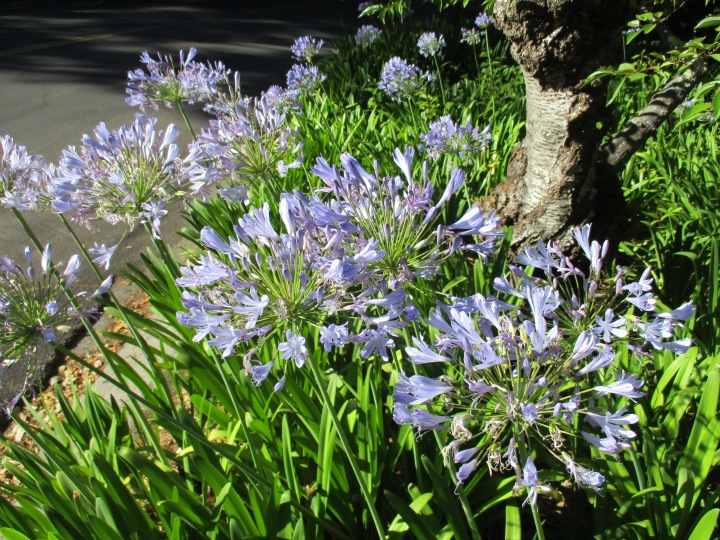
4. This zonal geranium has these small but cheery cherry red flowers, but it is really grown for the weirdly variegated foliage that is blurry in the background. I think that these flowers would look better against simple green foliage. There is another zonal geranium in another part of the landscape, with small peachy pink flowers and foliage that is variegated only with white. I am none too keen on the flower color, and I am not often too keen on variegation, but the foliage of that particular zonal geranium really looks sharp.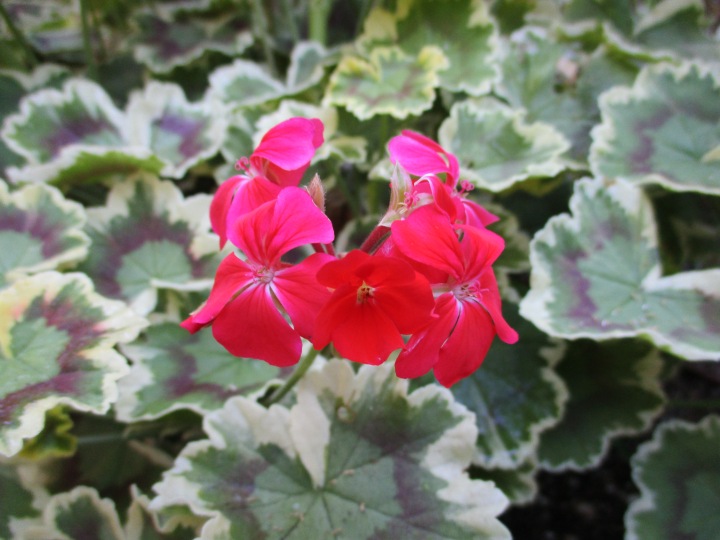
5. Himalayan blackberry is one of the worst and most invasive of the exotics weeds here. It develops huge canes that arch over and drop on top of other plants in the landscape. The wickedly sharp prickles (technical term for their thorns) are tortuous when trying to remove the canes. Even picking their berries is nasty business! There are a few berries ripening now, and they happen to be pretty good, but they are sooooooo not worth it.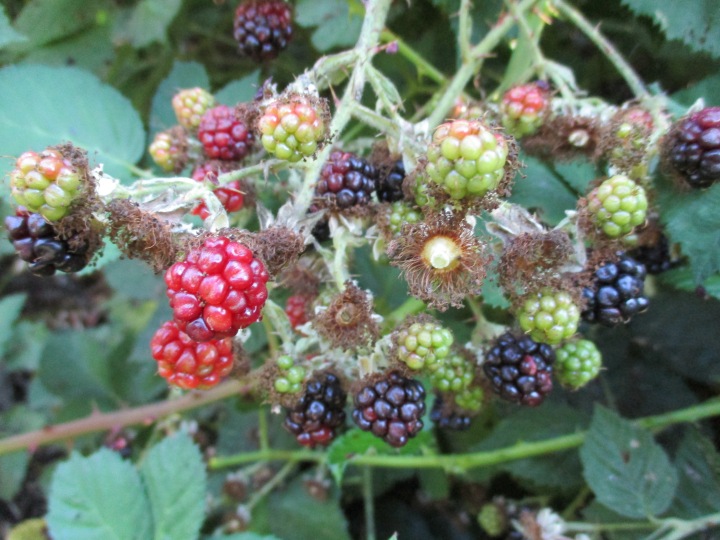
6. Chips needed to be dispersed into the newly landscaped areas that are partially visible in the background of this picture. These chips were free. They are made of recycled wood waste. For our purposes, they are sufficient. However, they include a few large chunks of wood and bits of metal. The chunk of metal in this picture is a short section of rebar. Some of the chips have paint on them. Some seem to be bits of old furniture. It makes one wonder where some of this material came from.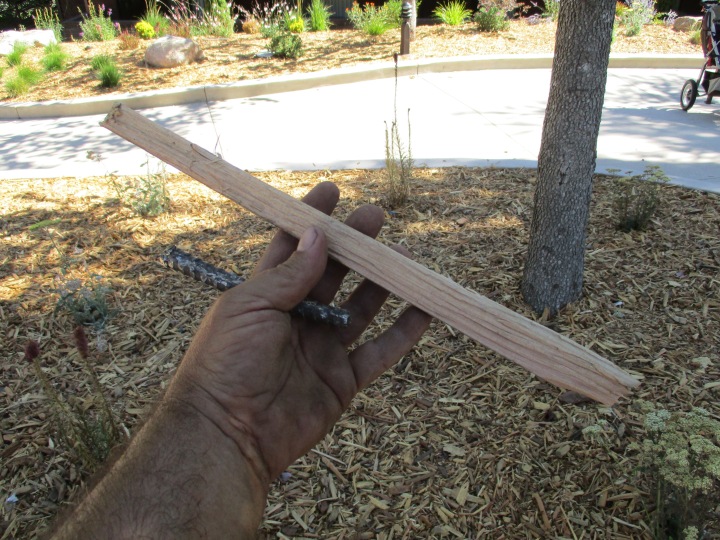
By the way, the bloom in the first picture #1 is merely a fist full of deadheaded white zonal geranium flowers all pressed together. White zonal geraniums do not readily drop their faded blooms like other zonal geraniums do, so they need to be deadheaded.
This is the link for Six on Saturday, for anyone else who would like to participate:
https://thepropagatorblog.wordpress.com/2017/09/18/six-on-saturday-a-participant-guide/
Number one looks like a dessicated hydrangea! I agree with you about aggies too. Uncomplaining and giving of their all, but mine are flattened by frost just now.
LikeLiked by 1 person
Oh, of course, . . . frost. I sometimes forget what that is. It was half a year ago, and not cold enough to bother much. Agapanthus are excellent foliar plants throughout the year here. The bloom is an added bonus in summer. Those in the picture are shaded, so do not bloom as much as they should, but even they are very nice.
LikeLike
I’m w/Jane on thinking it was a dried hydrangea flower. I do love that verigated zonal geranium. And it’s odd to think of phlox as rare! Shows what a bit more heat, a bit less rain’ll do to change what you can grow in the garden.
LikeLiked by 1 person
I sort of thought that others would guess it to be a dried hydrangea. Perhaps that is why I took a picture of it. The foliage on that white one is not variegated like the foliage of the other two. It is a zoneless zonal geranium. I like them all though. Even though I think that the weirdly variegated one is . . . well, weird, I think it looks really pretty for the situation it is in.
The weather here does not seem to limit phlox. It does just fine. No one knows why it is unpopular. There are a few plants that we do not grow merely because no one knows that they can be grown here.
LikeLike
O, I see! Obviously I thought it was the climate. Phlox smell so good, you’d think they’d be popular everywhere.
LikeLiked by 1 person
There are many plants that are notably absent or very uncommon here just because people do not know about them. Conversely, outsiders think that the common palms here will not grow elsewhere; but the windmill palm does quite well in Seattle and Oklahoma City.
LikeLiked by 1 person
Is Lily of the Nile the same thing as agapanthus?
LikeLiked by 1 person
Yes. At work, I actually refer to them as ‘agapanthus’ because it is a less cumbersome name. I only refer to them as ‘lily-of-the-Nile’ in writing because it sounds prettier, and because I get the impression that it is how most know them. They are very common to us, but I found that people in Oregon and Oklahoma are impressed by them.
LikeLike
I was going to ask the same question! Never heard of Lily of the Nile but I like it!
I was also going to guess hydrandea…dam. Everyone got there first!
LikeLiked by 1 person
In the wild, lily-of-the-Nile can survive under flood water for part of the year, and then tolerates serious drought and heat for the rest of the year. It can lose foliage to heat, but just makes more when it gets the chance. In colder climates, it loses foliage to frost. It is remarkably resilient.
LikeLiked by 2 people
Wow that is resilient….🤩
LikeLiked by 1 person
Tony, in one of the replies you say that agapantha can survive under water for awhile. I had always brought mine inside for the winter but had friends who said they would survive outside. So I planted one outside and it did survive. Did not bloom this summer, however. I have another pot and will plant it in that section of my garden that is underwater in the spring and then goes dry in the summer. Worth a try. I am getting tired of lugging pots into the house in the fall.
LikeLiked by 1 person
They survive flooding only if the water is circulating, or at least is not stagnating. I have found that they will rot in saturated soil! through which water does not flow freely. There is a difference between soil saturation and flooding.
LikeLike
That makes a difference. This particular bed has standing water in it after heavy rains. Thanks for the clarification.
LikeLiked by 1 person
Yes – as a gardener in Oklahoma, I must agree. I love that flower. Will it grow in Oklahoma? Maybe as an annual instead of a perennial?
LikeLiked by 1 person
It will not survive the winter in Oklahoma, so would need to be grown in pots and brought into shelter for winter. It will not perform as an annual because it will not get bit enough to bloom in the first year. To me, it would seem silly to grow in in pots, but I know of someone who does in Texas just because he likes the flowers so much.
LikeLiked by 2 people
I also thought of a huge white hydrangea flower, but if it’s a geranium, it’s also stunner! Is the Lily of the Nile the other name of agapanthus?
LikeLiked by 1 person
Oh, it is not ‘a’ geranium, but a fat fist full of deadheaded flowers all wadded together. ‘Lily-of-the-Nile’ is the common name of agapanthus. I just used the common name here because I get the impression that most know it as such, and because it sounds prettier.
LikeLiked by 1 person
I am deeply jealous of the agapanthus. Mine has succumbed to the heat – and I suspect from over potting last year – the flowers are a bit pathetic.
LikeLiked by 1 person
There is no need to be jealous. There are flowers for every climate and every region. Flowers that you think of as common might be quite rare here. Besides, if agapanthus grow there at all, they can recover from damage or mistreatment quite readily. They could be fine next year.
LikeLiked by 1 person
And, just to join the gang, I thought it was hydrangea too! I love pelargoniums, such wonderful colours and easy to grow. I am also a big fan of mulch, although I usually get mine from the tree surgeons, for free as well. Whatever, it does a good job!
LikeLiked by 1 person
Chips from tree services is just as good, and in some ways, even better. It is heavier, so stays put better. Also, although coarse, it is more finely textured, without the big chunks of furniture. When I was doing my internship, dumped chips on medians of highways. The crews who maintained the highways spread them out to inhibit weed growth. It was mutually beneficial. We got rid of our debris, and the highway crews put it to good use.
LikeLiked by 1 person
It is a win/win and that is always good!
LikeLiked by 1 person
Tony, I get chips from my tree service as well for certain parts of my garden. But a friend (a master gardener) told me that you can get plant diseases from the chips. I haven’t had any problems but wondered if you had an opinion.
LikeLiked by 1 person
It certainly is possible to transmit disease by recycling chips, but it is not often a serious problem. When Phytophthora ramorum (Sudden Oak Death Syndrome -SODS) was a serious problem here, any susceptible trees that were infected with it could not be recycled. Coast live oak could only be dispersed on site, but not be recycled elsewhere, even without obvious infection. In the East, any elm tree diagnosed with Dutch elm disease was quarantined and disposed of with no option of recycling the chips. The debris was hauled away without chipping because it was important to not inoculate the chippers. Any responsible tree service would dispose of potentially infectious chips. However, not all arborists know what diseases are serious problems in every region. Sycamore and ash that are infested with anthracnose are commonly recycled, but the infected chips do not seem to make the problem any worse than what is transmitted by wind.
LikeLiked by 1 person
If your phlox was taller, I’d guess it was ‘David’ that I used to grow in another garden.
LikeLiked by 1 person
I do not know how many generations it has self sown. It could have been from the first generation of seed ‘delivered’ by the horses, or it could be a distant descendant of a garden variety.
LikeLike
Delighted to see agapanthus in yr six and the phlox – mine is really struggling with the lack of water, but they do seem to pull through. Also like the zonal geranium, it’s subtle markings are more to my taste than the reddy-orange ones.
LikeLiked by 1 person
That variegation is not very subtle. People like the boldness of it, even though it does not get big at all. Are the reddy-orange ones just outfitted with a single dark (reddy-orange) hallow around the leaves, or are you referring to the flowers?
LikeLike
The leaves.
LikeLiked by 1 person
A nice selection! I do like pelargoniums – near here is a specialist nursery where I usually get mine and they have a wide selection, all kinds of flower and leaf types. This year I haven’t had chance to get any, though, which is a pity as they do well in hot weather. The phlox is a variety I’ve never ground but I do have some of the “creeping” phlox as ground cover and it does pretty well in our slightly sandy soil.
LikeLiked by 1 person
Have I been missing your posts?
My favorite pelargoniums are my two old zonal geraniums. I grow none of the fancy types, but I really like them because they can be planted and ignored in coastal gardens where not much else grows. My larger zonal geraniums do not like the wind much, but the lower ones are quite stout. I see more variety in the old gardens around town than in nurseries, because they have been getting planted here and there for decades.
LikeLike
I haven’t posted much lately – the garden’s a disaster zone! About to write something though, about a friend’s “mystery plant” so you may be able to help 🙂
LikeLiked by 1 person
I will probably catch it.
LikeLike
Himalayan blackberry has taken over vast parts of the landscape in Washington… It’s on par with kudzu. It spreads via seed and what I think are stolons. It’s the one weed that I don’t “chop and drop” – I take it straight to the trash can like I’m disposing of toxic waste.
LikeLiked by 1 person
I actually chop and drop it here because the stems dry and decompose rather readily. I only remove the canes where the thorns will be a problem if left. However, I do try to pull up the roots. Those are the difficult part to kill!
LikeLike
Yeah the thorns see brutal. They still penetrate heavy duty gloves with ease.
LikeLiked by 1 person
!
LikeLike
Thank you for the reminder of the lovely common name of the Agapanthus. Those Himalayan blackberries look lethal. Here in England our native blackberries are ripening earlier than usual thanks to the hot weather – blackberry and apple crumble here we come.
LikeLiked by 1 person
We use the names of agapanthus and lily-of-the-Nile interchangeably. There are many plants like that. However, I INSIST that Liquadambar styraciflua is SWEETGUM, not liquidambar. There is a long story behind that one.
Anyway, those Himalayan blackberries really are as lethal as they look. They are even worse in Oregon and Washington!
LikeLiked by 1 person
Six on Saturday is a great idea! I’ve read many of yours and if I can get my act together, I might try for once a month. I’ll need to figure out how to tag your blog when I do.
LikeLiked by 1 person
It is addictive! Once you do a Six on Saturday, you will want to do it every Saturday.
LikeLiked by 1 person